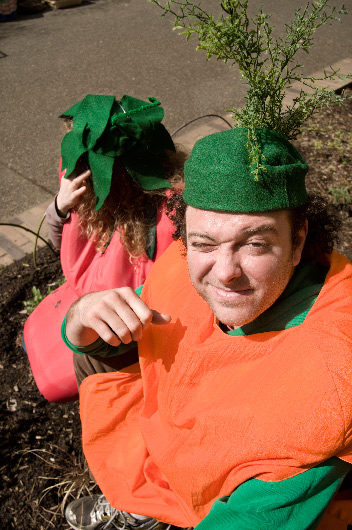Preparation 500
Preparation 500
From The Bear Deluxe magazine (June 2011)
1912 words
To our modern way of thinking, this all sounds quite insane.
– Rudolf Steiner, Lectures on Agriculture, 1924
Allan Balliett got sick in 1980. It came on as a flurry of symptoms, all of which seemed to take roost at once, and no one knew what was wrong or how to fix it. A systems analyst for the U.S. Department of the Treasury in Washington, D.C., Balliet suddenly found himself fatigued, his hair falling out “by the handfuls,” too weak and unfocused to adequately unravel the federal computer network. He says he “serial napped” on weekends 40 hours or more at a time.
“It was virtual narcolepsy,” Balliett explains. “I had a complete lack of creativity.”
Since mainstream docs could neither diagnose or treat him, Balliett turned to a naturopath whose pronouncement was “multiple chemical sensitivities,” the most egregious being a severe reaction to Calvin Klein cologne, which had just added “artificial ambergris” to its arsenal of libido-enhancing concoctions.
The cure? Get out of Washington, and off the daily diet of pesticides. Balliett says switching to organic food saved him, but he went a step farther. Like a growing number of Americans, he’s a convert to biodynamic agriculture, which markets itself as nicer than organic. More wholesome. More respectful toward the earth―and to the cosmos, whose astral choreography directs planting days, harvest days, and the beliefs and practices of biodynamic farmers.
Balliett, who now leases a 78-acre biodynamic farm in Shepherdstown, W.Va., says he’s healthier, happier, thanks to the biological and cosmic influence of a “spiritual science” whose corpus of “knowledge” leapt into the public domain from a podium in Breslau, Germany in 1924 when Austrian philosopher and architect Rudolph Steiner delivered a series of lectures linking the health of the planet, and therefore humankind, to such practices as burying hollowed-out cow horns packed with manure in the wounded earth, and stirring the resulting detritus in a watery vortex. Among the least nefarious of Steiner’s suggestions: cow horns―which grow down, not up―can be used to channel cosmic forces; thus a biodynamically inclined farmer should hollow them out, pack them with cow dung in winter, disinter them in spring, and spray the contents (along with decomposed flower petals and other muck) over one’s farm.
Steiner ‘knew’ this witches’ brew was a planetary restorative ... because he was one of two extant beings on Earth who’d accessed the Akasha Records―a body of wisdom that is the earth’s fifth element, compiled and transmitted to him by ancient beings of truth and light. The Lemurians. With whom he had spoken. 
It’s breeding, building, branching they say―bio-d’s promoters, and those who fear it―but how much is hard to tell. In France, Zind-Humbrecht, Coulée de Serrant, Domaine Leroy, and numerous other labels now offer biodynamic wines. California vintners Benziger and Fetzer are certified biodynamic by Demeter USA, the nation’s only agency that accredits the practices and products of the industry.
It’s “growing exponentially” in Washington state’s market, says Linda Chalker-Scott, Ph.D., associate professor of agriculture at Washington State University. She describes bio-d as “junk science” propagated by mythology, and argues that its supporters undermine scientific literacy.
Rebecca Briggs, communications director for the Biodynamic Gardening and Farming Association, headquartered in Junction City, Ore., says membership in the nonprofit has grown by 30 percent in the last year. Thirty percent of what overall number she couldn’t say, because the power was out after a March 14 windstorm, and the membership stats resided on a lifeless computer.
Joe Czerwinski, senior editor and tasting director for Wine Enthusiast magazine, says the industry is “aware” of biodynamics primarily because vintners are branding with the term, and turning a profit, not because of any perceptible impact on the quality of the wines themselves.
“You’d be hard pressed to tell the difference between biodynamic and other kinds of wines,” Czerwinski says. “A lot of famous winemakers have gone biodynamic, but they were making good wine before they did that … Maybe it’s a placebo effect; they believe there’s an impact, and consumers believe there’s an impact, and because they believe, there’s an impact.”
Demeter’s website states that biodynamic wines are distinctive in that “they are intimately connected to the estate,” and that biodynamic processes allow a vineyard to be “the best that it can be,” and finally, that this distinctiveness is bottled. There’s not much more than that, other than the certification requirements themselves, which are more restrictive than the regulations that govern “certified organic.” In addition to forgoing manufactured pesticides, however, biodynamic vineyards must set aside at least 10 percent of their acreage for biodiversity, and must “integrate” animals and animal feed, water use, perennial plants, flowers, trees and compost. If there is a qualitative or quantitative standard for what constitutes a measure of ‘integration’ between, say, rotting potatoes, the Western meadowlark and a blighted sugar maple, it can’t be found on their website.
Demeter (otherwise known as the Greek goddess of agriculture) had the foresight to sequester the term biodynamic as a registered trademark, meaning that any vintner who inks it on a label, without first paying certification dues to the Philomath, Ore. agency, may get their fullest sense of terroir in a courtroom.
Rudy Marchesi is one such registered biodynamic vintner. The owner of Montinore Vineyards in Hillsboro, Ore., Marchesi attributes his success to Steiner’s nine preparations; in sum, Steiner prescribes an admixture of water, yarrow, camomile, stinging nettle, oak bark, dandelions, valerian flowers, and the common horsetail. These, in addition to the dung scraped out of hollow cow horns, Marcesi broadcasts over his 230-acres with the help of a “dynamizer”—a stirring machine fashioned from the motor of a street sweeper, scrap metal, and the frame of a ‘73 Ford 4x4 pickup.
The contraption is necessary in order to stir the flower petals and the dung in harmony with the alignment of cosmic forces. But not out of whim or celestial deference; Marcesi and other bio-d farmers says such admixtures build soil health, and aid the natural defenses of plants. Marchesi observes that while non-biodynamic growers in the wine industry are ripping out their vines to combat Phylloxera (a sap-sucking insect resembling an aphid), his vines are robust and virtually disease free. “People farming conventionally had a much harder time.”
Shayn Bjornholm, education director for the Washington State Wine Commission, says biodynamic agriculture has no impact on combating Phylloxera, but adds, “Biodynamics can make great wines. Any course [of action] that forces you to be more attentive to your vines should result in higher quality grapes in the end.”
It works for him, says Marcesi. He also adds that 2010 was a damp, cool, “challenging year for grape growing,” with crop losses as 50 percent in Oregon’s Willamette Valley; the average loss, according to the Oregon Wine Board, was 22 percent. Marcesi says that biodynamics allowed him to produce a normal crop―600 tons of grapes (about 480,000 bottles).
“When you allow a plant to grow in a way that encourages life,” he adds, “the soil is going to be more hospitable. Vines are going to make more root hairs, and that not only adds to the health of the plant, but they also pick up subtle nuances that add to the complexity of the wine.”
Jacqueline Freeman, a biodynamic farmer in Venersborg, Wash., says she’s seen dramatic, conclusive proof that Steiner’s recommendations work. Freeman, who co-owns and operates Friendly Haven Farm, said she planted barley on a leaf day (Steiner said leafy things should be planted when cosmic forces were aligned to support ‘leafy’ things). Forty-eight hours later, when her bio-d astrological chart dictated a “root day,” she planted more barley in the same 4x8 bed (meaning ‘controlled conditions’). She was not attempting to do science, she admits. She was merely interrupted while sowing the first batch, and couldn’t get back to planting until two days later.
“Hardly anything grew” from the root-day barley, she observes. “But the ones planted on the proper day thrived. What I saw was a thicket of barley coming up, then a paucity next to it, in the same bed. Some [root-day barley] didn’t even germinate.”
There may be some problems with Freeman’s methodology, but even professional scientists have struggled to determine a causal link between Steiner’s prescriptions and any observable ‘improvement’ in either soil health, increased biomass or other measures of ‘plant vitality.’ Researchers at Washington State University in 2005 published the first peer-reviewed study (in The American Journal of Enology and Viticulture) of biodynamic practices, contrasted with organic methods. They concluded, “No consistent significant differences were found between the biodynamically treated and untreated plots for any of the physical, chemical, or biological parameters tested.”
Nevertheless, practitioners such as Marchesi stand by it as a form of agriculture that goes ‘beyond organic.’
“Organic mimics conventional agriculture in that you focus on productivity and problem solving,” Marchesi says. “One basic tenet is that we view the farm as one living organism. It’s not an environmental movement; it’s just a different way of looking at the world.”
Steiner called this practice, and this perception―the ability to perceive the wholeness or goodness of one’s relationship to land―“spiritual science.” He was a fan of “sensitive crystallization,” and “capillary dynamolosis,” but what he meant by those terms is anyone’s guess. Because his ‘science’ (and the more occult practices of biodynamic farmers) doesn’t lend itself to rational or quantitative analysis (and therefore isn’t ‘science’), it’s tough to define what effect it has on the phenomenological world. His agricultural insight, he said, was not the result of experimentation, but was directly transmitted from the cosmos, via intuition and meditation; in biodynamics, the result is a curious conjunction of astrology, uncommon sense, macrobiology and agri-voodoo. 
Steiner’s acolytes believe. Enough so—mystically, magically so—to follow the ritual practices: burying copper disks to harmonize cosmic forces, composting with resurrected dung, manufacturing the whirlygigs needed to broadcast the kosher slurry over field and pasture. Why? Because Steiner said these preparations were essential to restoring balance to the paraplectic soil. In this―the observation that agriculture, which had become an industry, had lost its respect for the earth, was seeding the planet with sickness and destruction―Steiner appears prescient. The year was 1924, and already Steiner had divined the bleak future; he claimed the planet was polluted and doomed unless we changed our malevolent ways.
While it’s been difficult to pin down any perceptible impact on soil health, or plant life on biodynamic farms (or products), few could argue that bio-d farmers are worse stewards of land than the disciples of Monsanto, Cyngenta, Tyson or the other agri-chemical giants whose science is sound―and is lethal.
Darron Joffe is a biodynamic farmer who’s well aware that bio-d’s ‘occult’ dimension gives some people the willies. Makes it easier for mainstream Americans to dismiss bio-d as something akin to voodoo. But like Balliett, who attributes his health to bio-d food and a bio-d outlook on the earth itself, Joffe believes the proof isn’t in the lab; it’s in the food Steiner’s followers produce.
As for doubters, Joffe (whose business is chartered as Farmer D Organics in Atlanta, Ga.) says, “I don’t have much dogma or get defensive any more. If people eat the food for a time―maybe a few weeks, a month―then they open up. Then they understand.” The End
03/25/13 | 0 Comments | Preparation 500